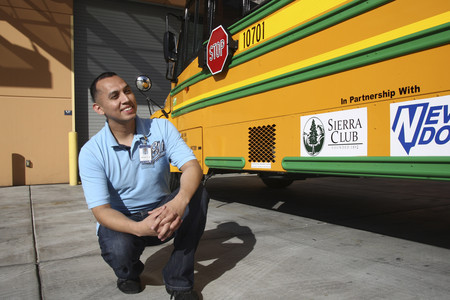Clark County School District goes green, buys a hybrid bus
The yellow school bus is going green.
On Tuesday after the Presidents Day holiday, a hybrid bus will begin transporting some students in the Clark County School District.
The bus, which is expected to be 50 percent more fuel efficient than a regular bus, is only the second hybrid sold by Thomas Built Buses in High Point, N.C.
"This is pretty exciting, pretty leading edge," said Jane Feldman, a member of the local chapter of the Sierra Club.
The school district is using $50,000 from its portion of a Sierra Club settlement with the Nevada Department of Transportation and the Federal Highway Administration to offset the cost of the more expensive hybrid.
In 2003, the Sierra Club challenged the expansion of U.S. Highway 95, arguing that the planners did not take sufficient steps to mitigate pollution. As part of the settlement, the school district received about $3.5 million for environmental initiatives because three schools are next to the highway and children are more vulnerable to air pollution, Feldman said.
The school district normally pays about $120,000 for a bus. The Thomas hybrids start around $150,000, but Clark County's hybrid costs about $170,000 because it was upgraded for air conditioning, said Frank Giordano, the director of the transportation department of the school district.
Without the Sierra Club settlement money, the school district would not have purchased the hybrid, Giordano said.
The additional cost doesn't pencil out even though the hybrid is expected to get 9 miles to the gallon compared to 6 mpg for a regular bus. The school district would have to wait about 20 years to get its return on investment, Giordano said, and buses normally are retired after 14 years.
The district will wait to see how the pilot hybrid works before investing in more, Giordano said. He also wants to see if the cost comes down.
The green-striped hybrid bus has some additional components that will require some maintenance but it's "nothing major," Giordano said. The district has a two-year bumper-to-bumper warranty to cover anything beyond routine maintenance.
The hybrid bus technology differs somewhat from that in gasoline-electric hybrid cars, such as the Toyota Prius, said Ken Hedgecock, vice president of sales for Thomas.
But the basic principle is the same, he said. The hybrid bus uses electrical power for ignition or start up and then switches to bio-diesel after traveling about an eighth of a mile.
"Obviously, you're using more power at the start up, so that's where we think we'll make the most savings," Hedgecock said.
Giordano wants to use the hybrid on a busy route with a "lot of stop and go" to maximize benefit. The hybrid will begin serving routes for Coronado High School, Del Webb Middle School and Wolff Elementary School, all located in Henderson. The district will rotate the bus among four routes.
Hedgecock said his company has gotten orders for 35 more hybrids from school districts around the country. Many school districts are using federal stimulus funds for the purchases.
The Clark County School District also applied for federal stimulus funding to make environmental upgrades to its bus fleet but didn't get a grant, Giordano said.
Over the years, the local school district has used funding from the Sierra Club settlement for many environmental initiatives, such as retrofitting more than a thousand buses to reduce pollution from emissions. Last year, the school district's transportation department got a Clean Air Award from the American Lung Association.
Buses also are equipped with small solar panels on their roofs to keep batteries from dying. A trickle of energy from the solar panels keeps batteries from burning out while the buses are parked and inactive for months in the summer heat, Giordano said.
Because all buses run on a 5 percent bio-diesel blend, it offset the need for about 200,000 gallons in regular diesel fuel last year, Giordano said.
Ingenuity has resulted in savings, too.
Raymond Negrete, a geographic information system specialist, came up with an idea for a "bus pool" that is expected to save about $450,000 in costs and 408,000 miles in unneeded travel this year.
After buses finish their morning routes, they park at one of four high schools, each located in a different corner of the valley. A shuttle then takes the drivers back to their cars at their bus yards and returns them to their bus for their afternoon routes.
Contact reporter James Haug at jhaug@reviewjournal.com or 702-374-7917.

















